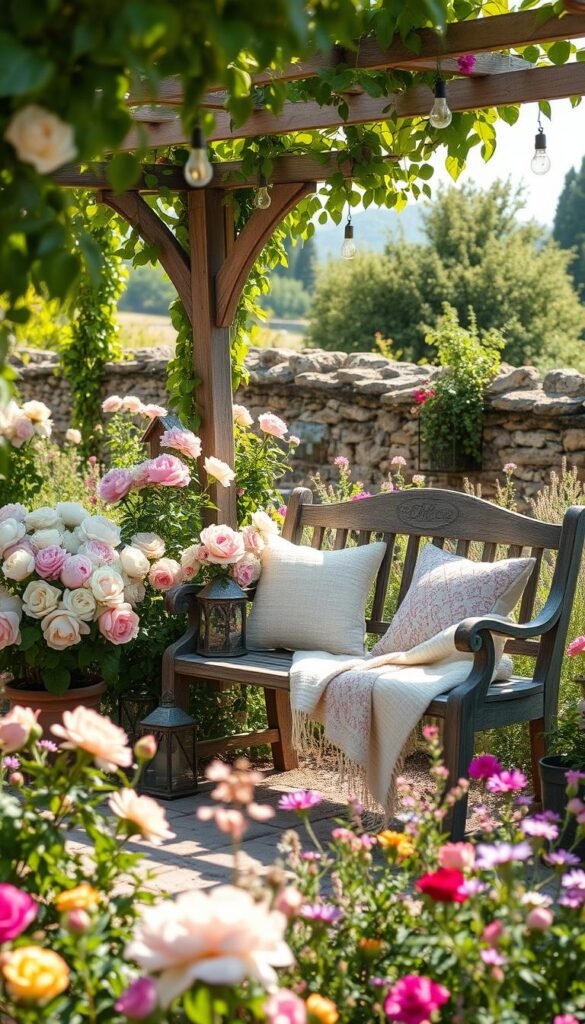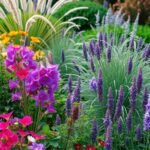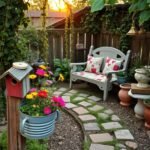Ever wandered into a space where colors dance freely and scents linger like old friends? That’s the magic of designing with nature’s spontaneity in mind. These spaces thrive on a wild yet intentional mix of textures, heights, and hues that feel both effortless and deeply personal.
Unlike rigid landscapes, this approach celebrates surprises. Think herbs peeking through climbing roses or weathered benches nestled among foxgloves. It’s about crafting corners that invite you to pause, breathe, and connect with the rhythms of the seasons.
What makes these designs endure? They balance nostalgic favorites like peonies and lavender with practical touches – think stone pathways or repurposed watering cans. You’ll attract butterflies and bees while creating nooks perfect for morning coffee or evening stargazing.
Whether you’re reimagining a sprawling yard or a tiny balcony, the secret lies in embracing imperfection. Let plants spill over edges. Allow sunlight to choose where daisies bloom. Here, every “mistake” becomes part of the story – and that’s where true character thrives.
Embracing the Cottage Garden Style
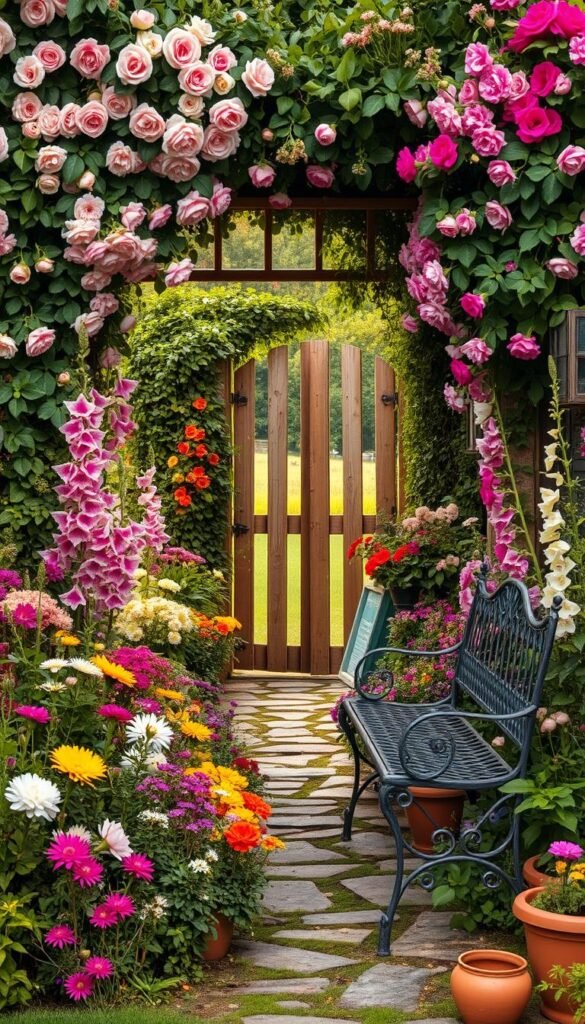
There’s a reason some spaces feel like they’ve been loved for generations. This approach to design thrives on blending natural abundance with casual comfort, creating areas that welcome both people and pollinators.
Discovering the Timeless Appeal
What keeps this look fresh decade after decade? It’s the clever mix of free-spirited growth and smart structure. Plants mingle freely – roses rub shoulders with sage, while daisies spill onto winding gravel paths. This isn’t chaos, but curated wildness that celebrates nature’s rhythms.
“The best gardens feel discovered, not designed,” notes landscape designer Bethany Rose. By combining edible herbs with ornamental blooms, you create spaces that nourish both body and soul. It’s gardening that values experience over perfection.
Setting a Cozy Outdoor Mood
Transform your patch into a retreat with three simple elements:
- Soft seating tucked under flowering arches
- Fragrant plants near gathering spots
- Gentle lighting that highlights textures
Use weathered materials that age gracefully – think iron lanterns or reclaimed wood benches. Let climbing plants frame your favorite view, and allow pathways to meander rather than march straight ahead. Your outdoor area becomes an extension of your living space, perfect for slow mornings or twilight conversations.
Celebrating Vintage Blooms in Your Garden
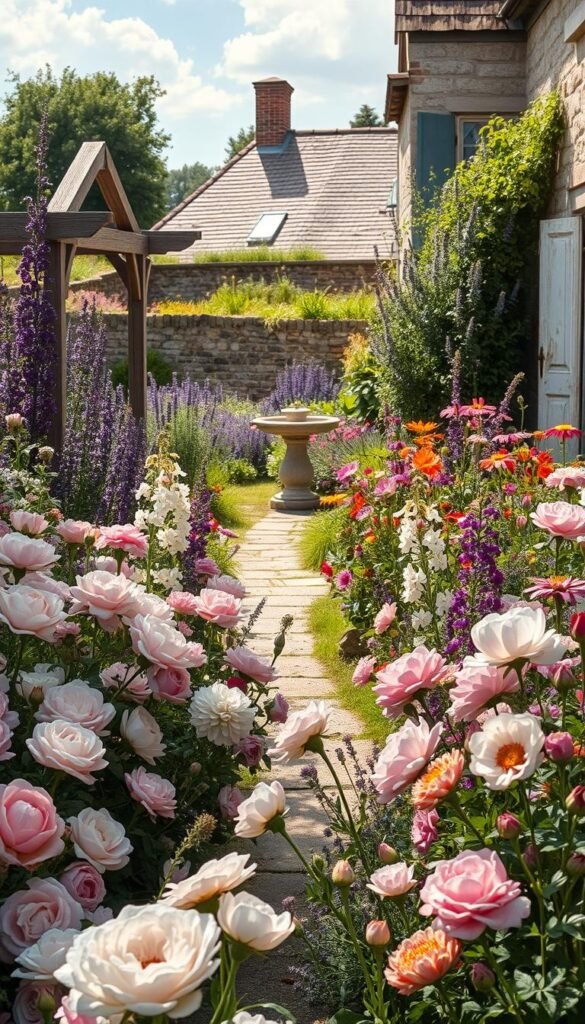
Imagine stepping into a space where every petal tells a story. Vintage varieties bring more than beauty—they carry generations of gardening wisdom. These resilient plants have adapted to thrive in diverse conditions, making them perfect for creating landscapes that feel both timeless and alive.
Why Vintage Flowers Stand Out
Tall, statuesque hollyhocks instantly draw the eye upward. Reaching heights of 8 feet, their vibrant towers of color transform plain fences into living tapestries. Best part? They practically plant themselves, returning year after year with minimal effort.
For texture and softness, peonies deliver unmatched charm. Their lush, layered petals create natural bouquets that perfume the air each spring. Unlike high-maintenance hybrids, these classics ask for little beyond well-drained soil and sunlight.
“Older varieties understand how to grow in community,” explains horticulturist Lila Greene. This makes them ideal companions for roses or lavender, creating layered beauty that evolves through the seasons.
Many heirloom blooms spread naturally, filling empty spots with cheerful volunteers. Their intense scents—often lost in modern breeding—invite pollinators while stirring memories of gardens past. It’s this blend of resilience and romance that keeps vintage flowers eternally relevant.
Integrating Cozy Decor Elements
What transforms a pretty garden into a place you never want to leave? The answer lies in thoughtful details that invite you to stay awhile. Start with weathered furniture that whispers stories of seasons past – a splintered bench here, a wrought iron chair there. These pieces become natural gathering spots where sunlight filters through leaves onto well-worn armrests.
Rustic Benches and Warm Textiles
Position seating where nature feels closest – under dappled shade or beside fragrant herbs. Add outdoor-safe cushions in earthy tones to weathered wood. A striped throw draped casually over a bench arm turns functional seating into a snug retreat. Pro tip: Choose fade-resistant fabrics that soften with time, mirroring your plants’ natural aging process.
Infusing Character with Vintage Accents
Scout flea markets for pieces that serve both form and function. An enamel watering can becomes a vase for cut blooms. Chipped planters host trailing ivy, their imperfections adding depth. “Every object should earn its place,” advises designer Marco Pérez. “A rusty lantern isn’t just decor – it’s a nightlight for fireflies.”
Keep arrangements loose. Let that iron bench peek through climbing nasturtiums. Allow ceramic pots to gather moss in shady corners. These layered touches create spaces that feel lived-in, welcoming both quiet reflection and shared laughter.
Cottage Flower Garden Charm: Combining Vintage Blooms and Cozy Decor

Have you ever noticed how certain spaces whisper “stay awhile” without saying a word? That’s the cottage garden effect – where plants and decor work together to create irresistible magnetism. It’s not about matching colors or perfect symmetry, but rather a joyful collision of life and texture.
Start by letting your flowers take center stage. Allow foxgloves to tower over brick walkways while lady’s mantle spills onto stepping stones. Roses can weave through iron trellises, their petals dusting weathered benches below. This layered approach creates depth and movement, guiding visitors through your space naturally.
Worried about the “messy” look? There’s method in the madness:
| Structured Garden | Cottage Style |
|---|---|
| Neat rows | Interplanted clusters |
| Single-height plants | Vertical layers |
| Seasonal color schemes | Year-round texture play |
| Formal pathways | Wandering trails |
“The magic happens when plants choose their neighbors,” says Massachusetts gardener Elena Torres. Her secret? Grouping varieties with complementary needs – like sun-loving poppies beside shade-seeking ferns. This creates self-sustaining microclimates that reduce maintenance.
Balance abundance with cozy moments. Tuck a painted chair between blooming shrubs or hang fairy lights in that wild rose arch. These human touches make the space feel lived-in rather than overgrown. Remember: pollinators adore the diversity, while guests appreciate the hidden seating nooks.
Your design should evolve with the seasons. Spring’s pastel tulips give way to summer’s bold hollyhocks, followed by autumn’s rust-colored sedum. Each phase offers new reasons to explore and relax in your ever-changing oasis.
Lush Flower Beds and Overflowing Borders
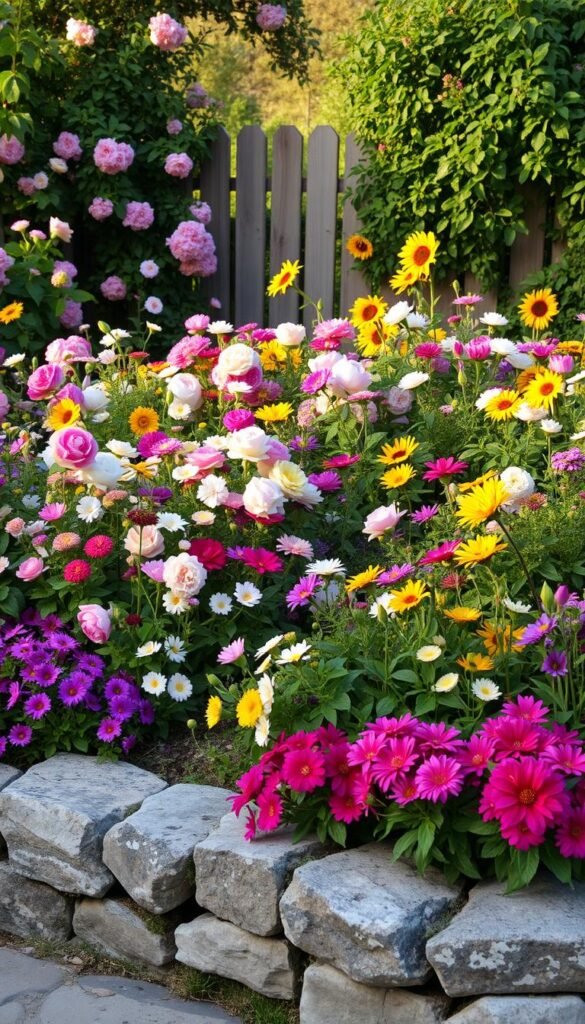
What makes a garden feel like it’s bursting with life? The secret lies in dense, layered planting that mimics nature’s generosity. By arranging your plants shoulder-to-shoulder, you create living tapestries where leaves brush against petals and stems support each other. This method hides bare soil while encouraging healthier growth through natural competition.
For those seeking cottage garden ideas, start with three key layers: tall anchors like sunflowers, mid-height bloomers such as roses, and ground-hugging herbs like thyme. This vertical mix ensures every inch contributes to the visual feast while creating microhabitats for beneficial insects.
Techniques for Abundant Blooms
Success begins below the surface. Enrich soil with compost to sustain closely packed roots. Space plants 8-12 inches apart – enough for airflow but tight enough to crowd out weeds. “Overlapping root systems act like living mulch,” explains Maryland grower Clara Nguyen. “They lock in moisture better than any synthetic ground cover.”
| Traditional Approach | Abundant Style |
|---|---|
| Wide spacing between plants | Tight clusters with overlapping foliage |
| Single-layer planting | Vertical layers (tall, medium, low) |
| Frequent weeding required | Natural weed suppression |
| Seasonal color focus | Year-round texture play |
Rotate bloom times for continuous color. Pair early risers like peonies with late performers like asters. Deadhead spent flowers weekly to redirect energy into new buds. Water deeply but less often – established clusters develop drought-resistant roots.
This approach isn’t just pretty. It builds self-sustaining ecosystems where plants thrive through mutual support. You’ll spend less time battling weeds and more time enjoying your ever-changing floral display.
Rustic Wood Accents and Climbing Vines
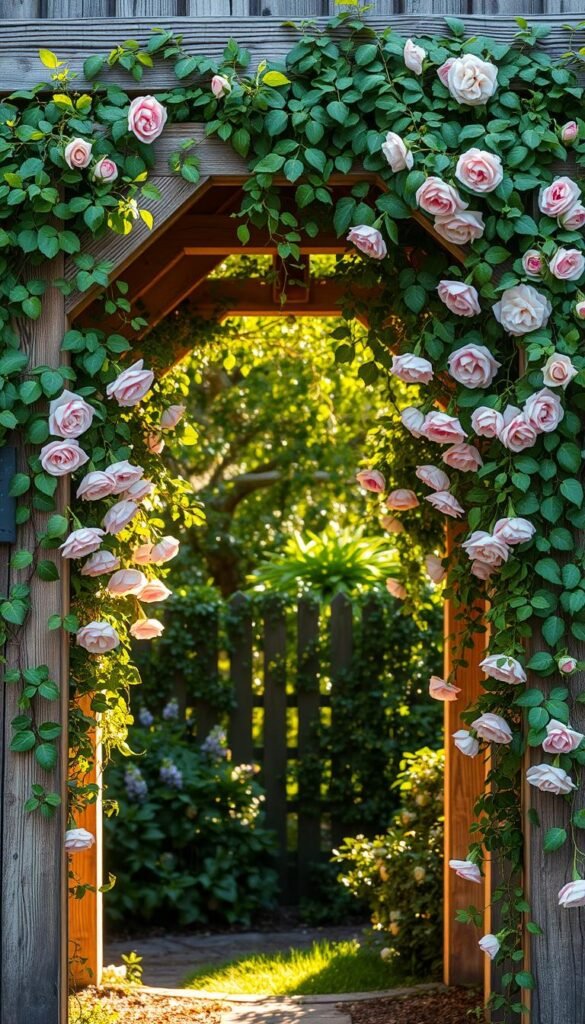
Picture an entrance where twisted vines frame your path like nature’s own curtain. Wooden archways draped with greenery create living thresholds that blend structure with wild beauty. These features guide visitors while supporting plants that evolve with the seasons.
Creating Wooden Archways and Entrances
Start with untreated cedar or redwood – both resist rot and develop a silvery patina over time. Space posts 4-5 feet apart for stability, burying bases 18 inches deep. “An arch should feel rooted, not temporary,” advises builder Tom Keller. Anchor climbing roses at the base, training stems horizontally for fuller coverage.
Choose easy-care varieties like ‘New Dawn’ roses. Their soft pink blossoms reappear from June through frost, needing only annual pruning and weekly watering. Pair them with clematis for layered blooms – the roses’ thorns even deter deer from nibbling delicate vines.
| Climbing Plant | Bloom Time | Care Level |
|---|---|---|
| Climbing Roses | Summer-Fall | Moderate |
| Clematis | Spring-Fall | Low |
| Honeysuckle | Summer | Easy |
| Jasmine | Summer | Moderate |
Prevent mildew by morning watering and spacing plants for airflow. Use jute ties to secure stems – they’ll decompose naturally as vines strengthen. Within two seasons, your arch becomes a fragrant tunnel where petals brush shoulders as you pass through.
For year-round interest, mix evergreens like ivy with seasonal bloomers. The wood ages gracefully, its cracks cradling tendrils that twist toward sunlight. This isn’t just a garden feature – it’s a living sculpture that grows more captivating each year.
Stone Paths, Brick Details, and Curved Trails
There’s something magical about how your feet know they’re entering special territory before your eyes do. A meandering stone path lined with nodding blooms creates anticipation with every step. Each irregular slab becomes a stepping stone through nature’s gallery, where lavender brushes your ankles and foxgloves tower like floral sentinels.
Building these walkways is simpler than you’d think. Choose flat stones and press them into ground softened by recent rain. Leave generous gaps for creeping thyme or moss to weave between. “Let the earth claim part of the path,” suggests landscaper June Whitaker. “Those green surprises make the journey as delightful as the destination.”
Curved designs work best for cottage-style spaces. Gentle bends slow your pace, letting you notice snapdragons peeking through cracks or bees dancing on sage. Compare straight vs winding routes:
| Straight Paths | Curved Trails |
|---|---|
| Predictable rhythm | Discover-around-every-corner feel |
| Emphasizes destination | Celebrates the journey |
| Requires precise edging | Forgives imperfect borders |
Mix materials for visual harmony. Pair irregular flagstones with brick details along seating areas. Use gravel for drainage in muddy spots – it whispers underfoot when you stroll at dusk. Just remember: encroaching roots add charm but need trimming twice yearly to keep trails navigable.
Your path will evolve like the rest of your garden. Let violets colonize sunny edges and ferns claim shady corners. Before long, you’ll have a living map that changes with the light and seasons – always inviting one more slow, meandering walk.
Cozy Patio Spaces and Secluded Garden Nooks
What transforms ordinary yards into places you want to linger? The answer lies in crafting intentional retreats that blend comfort with natural beauty. Imagine a bench framed by climbing roses, where morning light filters through hydrangea blooms onto a stone path. These spots become sanctuaries for reading, tea breaks, or simply watching bees dance among petals.
Designing Inviting Outdoor Seating
Start by positioning seating where nature feels closest – perhaps under a flowering arch or beside fragrant herbs. Weather-resistant cushions in earthy tones add softness to wooden benches. For extra charm, drape a lightweight throw over one arm. Pro tip: Use repurposed wooden crates as side tables to hold books or lemonade glasses.
Create depth by mixing heights and textures. Let ivy cascade from hanging planters near your seat. Place low-growing thyme where toes can brush its leaves. Soft lighting transforms these areas at dusk – try solar-powered lanterns tucked among ferns.
Remember: The best nooks feel discovered, not staged. Allow plants to graze chair arms and moss to soften stone edges. Your hidden corner will become the spot where time slows, and every deep breath tastes like summer.

